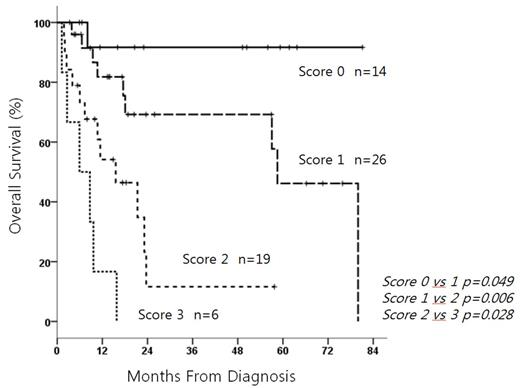Abstract
Introduction: The prognostic value of absolute lymphocytic count (ALC) has been a recent matter of debate in the study of non-Hodgkin-lymphoma (NHL). Recent observations show that variables related to host adaptive immunity and the tumor microenvironment are significant prognostic variables in NHL. Primary central nervous system lymphoma (PCNSL) is an aggressive and rare extranodal non-Hodgkin's lymphoma. The purpose of this study was to analyze prognostic factors for patients with PCNSL in order to evaluate the prognostic value of ALC at diagnosis and establish a prognostic model.
Method: Data from a total of 74 patients who were newly diagnosed PCNSL between January 2003 and December 2013 at Severance Hospital was retrospectively analyzed. All patients of this cohort received high dose methotrexate-based chemotherapy and outcomes according to the regimens were not significantly different. Cut-off of ALC was determined according to the literature data (1 ¡¿ 109/L). Pre-treatment Epstein-Barr virus (EBV) –DNA was isolated from whole blood samples. The detection limit was 2,890 copies/mL.
Result: Median age was 56.5 (range, 33 to 79) and median follow up duration was 55.4 months (range, 3.8 to 135.6). According to the International Extranodal Lymphoma Study Group scoring system, risk was classified as low in 13 (22 %) patients, intermediate in 38 (64.4 %) patients, and high in 8 (13.6 %) patients. According to the Memorial Sloan-Kettering Cancer Center Prognostic Model, risk was classified as low in 24 (32.4 %) patients, intermediate in 27 (36.5 %) patients, and high in 23 (31.1 %) patients. In this study, both classification models did not show the significant difference between low risk and intermediate risk. In univariate analysis, Eastern Cooperative Oncology Group performance status (ECOG PS) more than 1, age more than 50 years, EBV-DNA positivity in whole blood and low ALC at diagnosis were significantly associated with a worse survival. The proportion of EBV-DNA positivity was higher in patients with low ALC (30.8% vs. 10%, P = 0.05). In multivariate analysis, ECOG PS more than 1 (Hazard ratio (HR) 4.62, P = 0.001), age more than 50 years (HR 5.07, P = 0.009), low ALC with EBV-DNA positivity (HR 2.74, P = 0.049) at diagnosis remained independent prognostic factors for overall survival rates. ECOG PS more than 1 (HR 2.17, P = 0.021) and low ALC (HR 1.99, P = 0.043) were independent factors for worse progression-free survival rates. Especially, only low ACL was associated with early mortality during the first year in multivariate analysis (HR 2.18, P = 0.031). Early mortality during the first year was 34.1% for the lower ALC group and 60% for the higher ALC group (P = 0.01). Based on the observations from multivariate analysis, we constructed a new three-factor prognostic model using ECOG PS > 1, age > 50, low ALC with EBV-DNA positivity. This new three-factor model was successful for separating the outcomes of patients in four risk groups (5-year OS of patients with 0,1,2, and 3 factors were 91.7%, 46.1%, 11.6%, 0%, respectively, P < 0.001) (Figure 1).
Conclusion: ALC at diagnosis seems to be a useful prognostic factor for long term survival and a predictor early mortality in PCNSL. The novel prognostic score using ALC and EBV-DNA positivity may be a simple, statistically powerful model for newly diagnosed PCNSL patients and would be helpful in the design of future clinical trials. The proposed three-factor model should be validated in large-scale studies.
Overall survival of PCNSL patients according to the new prognostic model
No relevant conflicts of interest to declare.
Author notes
Asterisk with author names denotes non-ASH members.


This feature is available to Subscribers Only
Sign In or Create an Account Close Modal